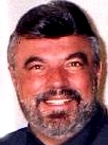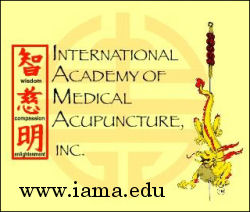Acupuncture & TCM Articles

Acupuncture Articles
by John A. Amaro L.Ac., Dipl.Ac.(NCCAOM), DC
 Dr. Amaro is an internationally known author, lecturer and practitioner beginning his practice of Acupuncture and Chiropractic in 1971. He has led 13 diplomatic Acupuncture study tours of The People's Republic of China escorting more than 500 doctors and practitioners. He has personally studied Acupuncture in nine separate Asian nations. Dr. Amaro is an internationally known author, lecturer and practitioner beginning his practice of Acupuncture and Chiropractic in 1971. He has led 13 diplomatic Acupuncture study tours of The People's Republic of China escorting more than 500 doctors and practitioners. He has personally studied Acupuncture in nine separate Asian nations.
He has received Certification in Acupuncture through the Columbia Institute of Chiropractic in 1973. This was one of the first Acupuncture postgraduate education programs for physicians in North America commencing in 1972.
He has been certified by the Waseda Acupuncture College in Tokyo, Japan in 1974 and graduated from the Chinese Medical Institute, Kowloon, China in 1976. He had previously taken postgraduate studies at the Tai Chung Medical School Taipei, China 1973.
Spectacular Acupuncture points in
diffuse musculo-skeletal pain
with or without needles!
John A. Amaro L.Ac., Dipl.Ac.(NCCAOM), DC
The treatment of musculoskeletal conditions by Acupuncture is legendary. There are perhaps no modalities in the healing arts, which are as effective for specific area pain relief. As a general rule, Acupuncture is most easily applied to a particular joint or area of musculoskeletal complaint with the use of acupuncture point stimulation at the area of complaint. This procedure known as "Surround the Dragon" is one of the most classic of acupuncture techniques. It is used throughout the acupuncture world and has been for centuries. But what happens when the pain is extreme and diffuse throughout the body? How do we treat, where is our focus?
In "Surround the Dragon" for localized problem areas, acupuncturists simply palpate tender (ah shi) points in and around the area of complaint and simply stimulate them. Any form of stimulation is effective. Even though needle stimulation is most often thought of as acupuncture, it must be remembered, "Acupuncture is a principle, not a technique". Therefore, many forms of stimulation are as effective as needles to include simple electronic stimulation, non-invasive pressure stimulation through a "teishein", red light laser stimulation, heat, cold, pressure and ultrasound. In addition to "Surround the Dragon" Traditional Chinese Medicine (TCM) recognizes three patterns of disease which are most often connected with diffuse systemic pain and are extremely important to treat, they are "Dampness", "Blood Vacuity (deficiency)" and "Exterior Wind".
Dampness is primarily associated with loose stool, fatigue, nausea, general heaviness in the body, multiple painful sites and joint stiffness with difficulty in locating an exact point of pain. The tongue is greasy and the pulse is slippery and boggy. According to TCM, the way to treat this situation is to remove dampness by supplementing the spleen. When musculoskeletal conditions arise as a result of dampness, it responds remarkably well to the liberal use of moxa which can be used through the use of a moxa stick held close to specific points or by attaching moxa to the end of the needle and allowing it to burn. A practical approach is to have the practitioner mark the points for the patient and have the patient apply warming moxa to the specific points at home through the use of a moxa stick held close to the point. There are a number of very specific acupuncture points, which have a remarkable effect on conditions brought on by dampness they include:

Acupuncture in the
Treatment of Pain
· GB 34 (outside of knee) the most important of all the musculoskeletal points of multiple site pain origins.
· ST40 classically used to disperse phlegm.
· SP 9 (inside of knee) removes dampness.
· JEN MO 9 (CV 9) removes dampness.
· SP 3, SP 6, supplements spleen Qi.
· BL 20 (Associated point for the Spleen)
· LIV 13 (Alarm point for the Spleen tip of the 11th rib). Major meeting points of the Viscera.
· (JEN MO 12 (CV 12) with CX (P) 6 are extremely effective in conditions of nausea and constriction of the chest as a result of dampness.
· ST 36 supplements spleen qi.
· SP 21 Great Luo point. Deals with any systemic pain due to dampness.
"Exterior Wind" is a common occurrence which is responsible for multiple muslculoskeletal pain sites. Even though exterior wind can produce multiple pain sites, it is most often associated with the neck, upper back and shoulders. Wind generally is much more of an acute pain than that of dampness coming on very quickly even in the otherwise healthy individual. These conditions usually occur when the patient has been in direct wind situations, such as having a fan or air conditioning duct blowing on them. It may even occur when a patient is protected from the wind but wind is exhibiting itself in the environment such as a very windy day. It is the energy of wind in the environment which is the culprit. In these situations the extraordinary meridians become taxed which generally produces the pain. In TCM the tongue has a thin white coat and the pulse is considered floating. In needle therapy it is suggested to use a superficial stimulation. In situations where cold is combined with wind, moxa to the points are very effective. The points of significance in wind conditions are:
· GB 34 specific meeting point for all the sinews.
· GB 31 disperses wind from the lower half of the body.
· LI 4 disperses wind from the upper half of the body.
· BL 12 point where perverse wind energy enters the body, disperses wind.
· BL 10, GB 20 points just below the occiput. These points disperse wind and also are points where wind enters the body.
· BL 11 point of significance for any bone problem.
· TH 5 and GB 41 master points for the balancing of the Yang Wei Mo and Du Mai. Very significant in any multiple joint or musculoskeletal pain especially as connected with arthritis.
· SI 3 and BL 62 master points for multiple pain especially of the back. Deals with the Governing Vessel and Yang Qiao Mai.
· GV 14 and LI 11 used in fever.
"Blood Vacuity (deficiency)" this pattern creates very diffuse pain, which is relatively mild and produces discomfort on palpation throughout the body. The pain is most often described as being in the flesh as opposed to the joints or muscles. The patient generally presents appearing sick with symptoms of pale dry skin, brittleness of the nails, fatigue, insomnia, nervousness, vertigo and general emaciation. In TCM diagnosis the pulse is thready and the tongue is pale. Treatment is focused on supplementing Qi and blood and supporting the spleen. It is advised to use few needles and to avoid strong stimulation. Moxa is also effective when used with a moxa stick applied to the point. Points of significance are:
· ST 37, ST 39 used for vague general pain with lowered energy. Sea of Blood points.
· SP 4 master point for supplementing blood and affecting the spleen meridian.
· SI 6 powerful point for general pain in the elderly or very weak.
· BL 11 great bone point but also a point associated with Sea of Blood.
· BL 20 associated point for the spleen.
· BL 17 diaphragm point but also meeting point of blood.
· GB 34 master point for the sinews.
· SP 10 powerful point to increase blood.
· ST 36, SP 6, supplements spleen and affects blood.
The points you have been presented with here are some of the most classic points historically used by "Masters" in the field of acupuncture. They are simple to use, especially with non-invasive procedure and produce spectacular results. Should you use needles, use caution as to not leave the needles indwelling more than 20 minutes maximum. If you are having the patient use a moxa roll on the points themselves at home, remember to just warm the point as opposed to overheating it. I have written this article for those who are familiar with the location of the aforementioned acupuncture points. If you are a neophyte or confused as to the location of these points, be sure to include acupuncture postgraduate education in your schedule this year. You absolutely cannot afford not to. You've been given the keys, now go out and open the doors to allow the pain to leave. Let me know of your stellar cases.
|
